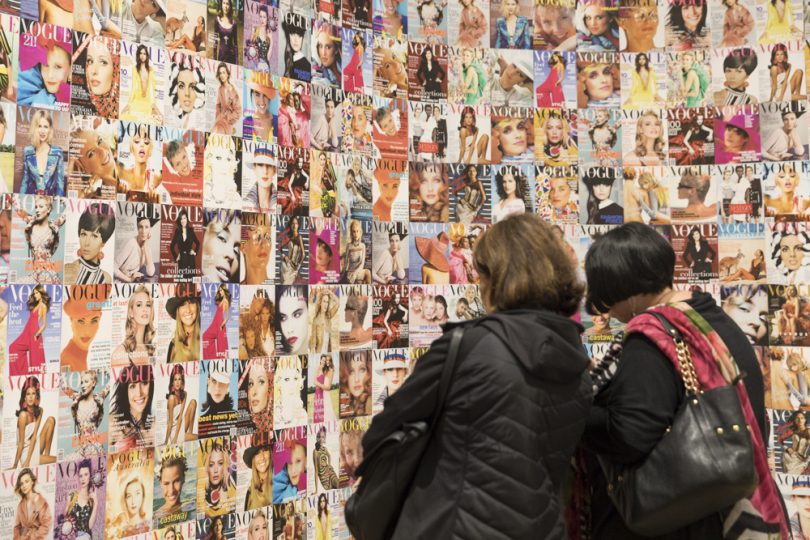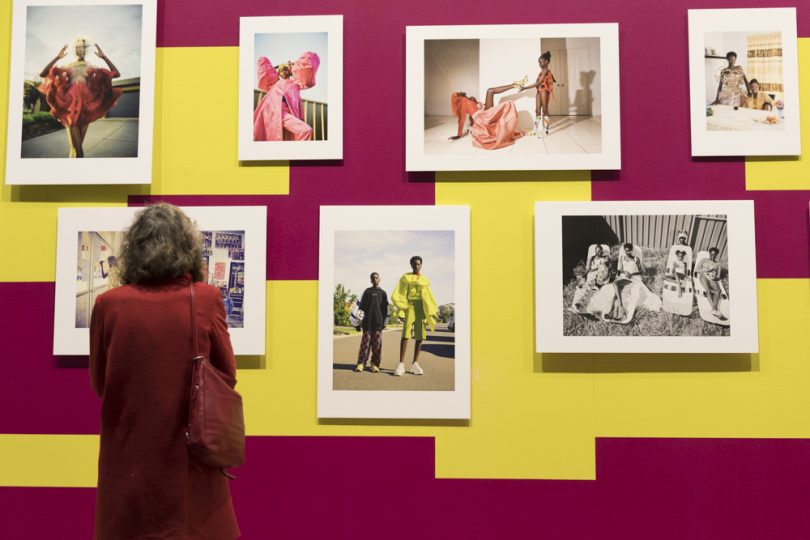
Curator Aimee Board at the National Portrait Gallery’s Vogue exhibition with Julie Bishop’s red shoes. Photos: Michelle Kroll, Region Media.
If you take the pages of Australia’s most venerable fashion magazine, scale up the images (often shot by the world’s best photographers) what you get is a series of portraits. But Women in Vogue at the National Portrait Gallery is so much more than a parade of beautiful faces.
It’s also a 60-year document of how women were perceived and portrayed, how they found their voice and confidence, and how their world changed.
The show was opened by Julie Bishop, and the fabulous red shoes she wore when resigning from Parliament are on display. They serve as a demonstration of how clothes can be used and worn strategically, sometimes even as weapons.
But that’s not how the exhibition starts.
Norman Parkinson shot the first Vogue cover in 1959, and it’s all soft Hollywood light and glow, women as decorative objects with few interests besides their own appearance.
“Looking through the 60s and 70s issues of Vogue, women were mere human mannequins,” curator Aimee Board says. “They’re not credited in any way. There’s that warm demure, staid gaze towards the lens. We do have some interesting photographers, the likes of Irving Penn and Lord Snowdon, but the images are still conservative, all about the colours and makeup and the accessories.”

The massed covers of 60 years of Vogue Australia editions.
Nearby, a lovely old 1950s television shows Mary Rossi guiding women through the latest from the Paris shows. But Maggie Tabberer, the first Australian to appear on the local Vogue cover, has a different story entirely.
Discovered as a housewife in South Australia by the legendary Helmut Newton, Tabberer blazed through Australian fashion before tossing it all in to start her own PR agency. Eventually, she became the face of The Australian Women’s Weekly.
As second-wave feminism advanced, there’s a corresponding, strongly noticeable change in how women are depicted on the covers and inside the pages of Vogue.
“You can see a lot more attitude,” Board says. “Early on it’s all about the fashions, travel, the seasonal colours, but the later headlines focus on women’s issues of the day like abortion and the complexities of a working woman’s life.”
Vogue also traced the rise of celebrity culture in the 80s and 90s: there are several images of Kylie Minogue after she recovered from cancer and as a powerfully successful 50-year-old.

South Sudanese-born model Adut Akech and her family in a recent Vogue shoot.
Eileen George was the magazine’s first indigenous cover model in 1993, followed by model Samantha Harris and singer Christine Anu. You see the mod garb of the early 70s, Prue Acton’s fresh Australian eye and a spectacular black and white caftan designed by Dame Zara Holt which was pictured in all six international Vogue editions.
Among a handful of other garments on display (along with those famous red shoes) is an exquisitely tailored dress made by Martin Grant who grew up in Nunawading and studied sculpture briefly before going to Paris to find fame as the couturier’s couturier.
There’s a strong link to post-war European migration and the immense cultural impact it had on this country too. Vogue Australia founder Bernard Leser escaped from Germany with his family on the eve of Kristallnacht, after his father was forewarned by a Nazi whose life he had saved in the First World War.
Part of the influx of European energy and creativity in the arts, Leser would go on to head British Vogue and work globally with Vogue‘s publisher Conde Nast.
Aimee Board reflects that while there is undoubtedly a focus on “the elitist white colonial woman”, the likes of Lady Potter, and the Packer women, that’s increasingly challenged today by the industry’s willingness to embrace many different kinds of beauty.
In the final room, transgender model Andreja Pejic appears alongside South Sudanese model Adut Akech, who is one of the hottest catwalk models in the world. Akech is shot at her suburban family home at Adelaide, wearing gloriously over the top designer clothes among her giggling siblings and high school friends.
She’s the Vogue millennial woman of today: purposeful, driven, influential and mirroring the 21st century’s inclusivity.
Women in Vogue: celebrating 60 years in Australia is at the National Portrait Gallery until 24 November.
Original Article published by Genevieve Jacobs on The RiotACT.






